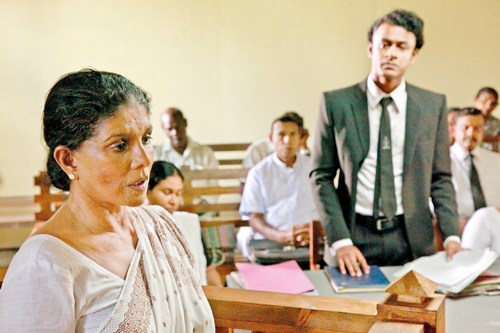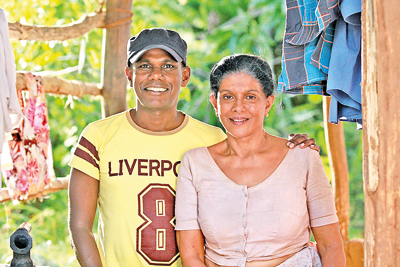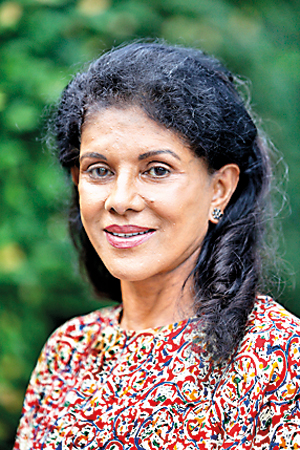Nita shines bright at Nice with her poignant role

A mother’s agony: Nita in a courtroom scene in ‘Paangshu’
Nice paid homage to a bourgeoning new Sri Lankan cinema on Saturday May 18, when the International Film Festival there recognized two key players of one of the most poignant Lankan films to come out this year- Paangshu (Earth), where director Visakesa Chandrasekeram casts back to the tragic murky depths the island was plunged into during the late 1980s with the second JVP insurgency.
Nita Fernando won the award for Best Actress in the Foreign Language Film category while Kumara Karawdeniya was adjudged the Best Costume Designer at the Festival.
The effervescent Nita wears the accolade with humble modesty that so endears her. She is no stranger to international recognition, having been Best Actress at the Singapore International Film Festival in 1998.
Looking back on her career, you get a whiff of this curious sense of destiny. By the end of her first decade in the cinema, she was cast in the role that was to iconize her. This was Nilupa Suraweera in Wijaya Dharma Sri’s Duhulu Malak, the first Sinhala film to explore adultery and all its tentacles of temptation. She was the pretty wayward wife. Before the film was released Nita had left for Canada, but venomous hate mail would tag her there, signed by the staid filmgoers of Sri Lanka who could not forgive her even though at the end Nilupa terminates the affair and returns to her husband and to fidelity.
Her second landmark role in the much more classic Pavuru Walalu (which brought victory at Singapore) was also of a woman torn between family, social obligations and love. The story was set in the stolid Christian middle class respectability of the Galle Fort, where Violet, a single mother of two grown up daughters, finds her life turned upside down with the sudden appearance from the shadows of the past, of the first and only love of her life.

Nita on set with director Visakesa Chandrasekeram
Paangshu, Nita says, was the most difficult role she ever handled. It is the story of a woman in Anuradhapura who, in the aftermath of the 1987-1990 insurgency, seeks justice for her son who was abducted by a paramilitary group.
Babanorna is a rada woman, from the downtrodden caste of launderers. Nita, who has something bordering on aquaphobia, had to learn to swim over months- using the backstroke because she could never ‘face’ the water. It was essential that she braved a torrential river in one scene, because at one point Babarnona decides to hide the gun, with which the police claims her son shot someone, deep in the riverbed.
Among those first and most moved by Nita’s portrayal was director Visakesa himself. “Nita gives flesh and emotions to this character,” says Visakesa, “carrying the total burden of a mother whose quest is to find her son and punish the criminals.”
Visakesa believes that Nita gave her most outstanding performance yet with this grieving mother.
The deep sense of heroic pathos in this poor, downtrodden figure, which moved the judges at Nice, was born out of a seed that germinated decades ago during the insurgency. As a boy peeping out of his father’s car window somewhere within the North Central Province, Visakesa had watched an old woman pleading with army soldiers at the gate of a camp.
“I remember, wiping her tears she spoke in a feeble voice: ‘… if he has done anything wrong you may break his arm or a leg but please send him back alive’.”

Nita Fernando
At this point he realized that “I had to do something in my own way, with my limited capacity, to stop such atrocities.” He wanted to “share these stories of these innocent people and make their stories alive in the memory of the people, so they will reject violence.”
Nita in her turn, speaking of Visakesa, has much respect to accord her young director. It was a completely novel experience- for ‘Vissa’, who with talents branching out like a spreading elm, has his own way of setting about the pre-shooting process.
Visakesa, knowing well that ‘film is a visual language’ and that text helps little in grasping visual elements, sketches picture frames of the film first. His vivid sketches provided Nita at once with deep insight into her role and into Paangshu. The script is born much later, very defined and fully fledged though nascent. Nary a wonder that Paangshu’s script was among those shortlisted for the best this year at Nice.
As with his previous film Frangipani, Visakesa touches a deep chord here. The title Paangshu comes with many connotations. There is the paangshu-kule rite, depicted in the film, where a cloth is given to the Sangha in the memory of a dead person. Also it is a reminder that we are all destined to be particles of paangshu (Sinhala for both ‘earth’ and ‘soil’) at the end. But the deepest reference would be to that the film exhumes a lot of souls, a lot of stories, and a lot of grief, all of them buried uneasily, their rumblings still menacing.
For Visakesa firmly believes that this past should be dug up. “I am of the view that post-war reconciliation cannot be facilitated ignoring these crimes that occurred during the Sinhalese insurgencies,” he stresses.
Visakesa has always striven to understand these cycles of violence and insurgencies claiming thousands of lives. “Being a person of mixed race (Sinhalese and Tamil) I felt the pains of the people in both ethnic groups. I have seen the suffering of so many women who have lost their husbands, brothers of sons. I always wanted to understand their suffering and share their stories with others, hoping to build their trust on democratic means of solving conflicts.”
Nadie Kammallaweera, who starred alongside Nita Fernando, echoes Visakesa when she marvels at how modest and receptive to new experiences and new insights from ‘youngsters’, this leading lady of the cinema proved to be.
Nadie believes Paangshu can be a watershed in our cinema. The young bright firebrand of an actress points out that one of the most blazing of elements in Paangshu is how higher officials responsible for thousands of young lives remain unpunished, while thousands of mothers still wait for their children and the soldiers who acted under higher orders have become physically and mentally ill- many of them prey to post traumatic stress disorder and other complications.
Nadie hopes the film will soon be screened in the country – “it is imperative that all of us get to watch it soon.”
| Dark period etched in Kumara’s mind | |
 Kumara Karawdeniya at the Nice film festival Kumara Karawdeniya earned Sri Lanka the first award for Costume Design at an international film festival. The overall art designer of Paangshu, this stickler for detail had the task of recreating the sartorial feel of the late 80s to the mid-90s, in a poverty stricken low-country milieu. Kumara, unfortunately, had been in the thick of the dark, tumulous period of strife in 1987-90, having lost both friends and family. Visakesa notes that he dug into the work with fervent passion and meticulousness- all the more so given that the period was scorched on to his memory. Having been mentored by Kanchana Thalpawila, Kumara had his debut as costume designer in Mille Soya (2004), and was noted for his work with Sulang Kirilli, Guerrilla Marketing and Aloko Udapadi. For Kumara, the dazzling spring night in South of France had been a ritzy but congenial and heart-warming celebration. Having flown back Thursday night, he recalls how, though the only Sri Lankan present, he was readily drawn into the heart of the camaraderie. “I never felt alone, and even when I collected the award for Nita, the applause, the whistling and the cheer nearly brought down the house; it was amazing.” |


